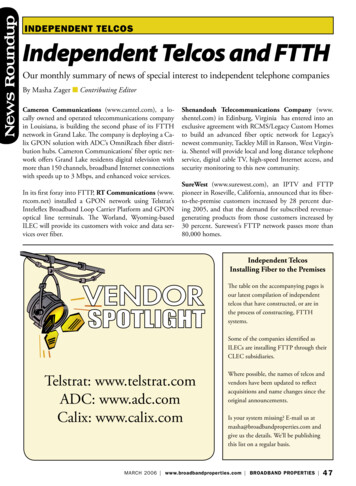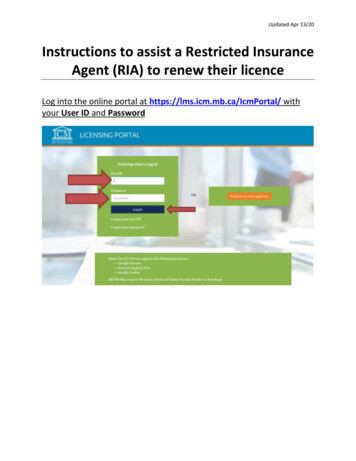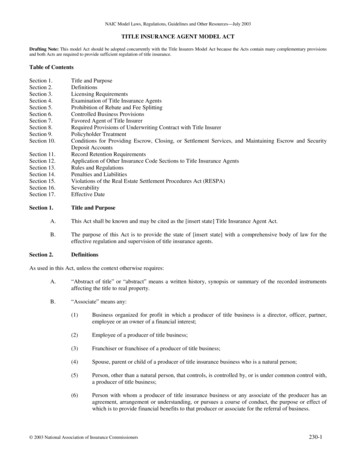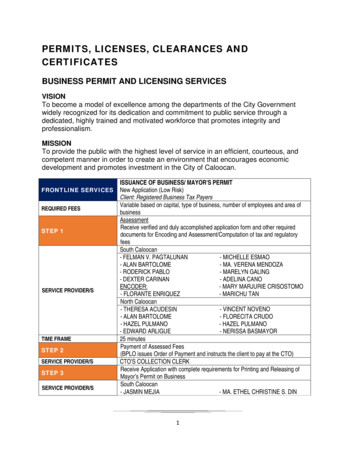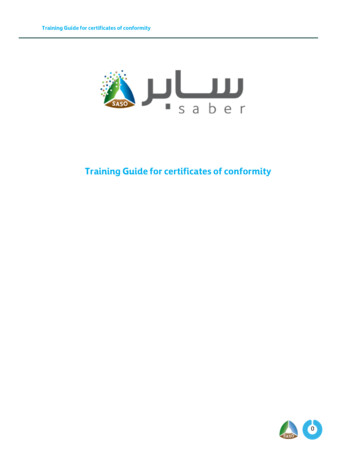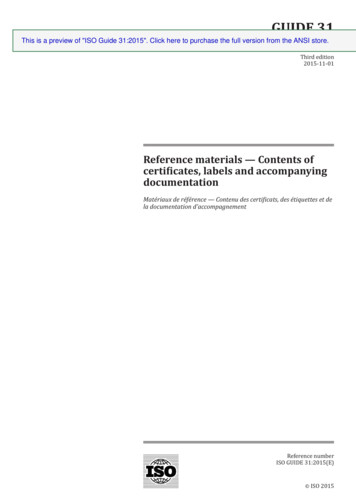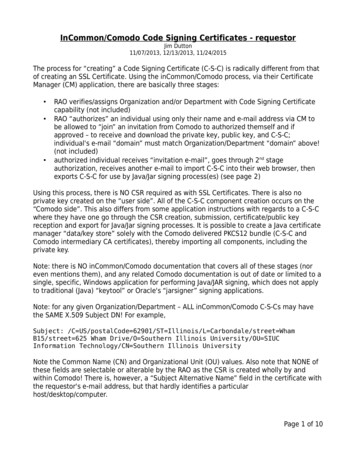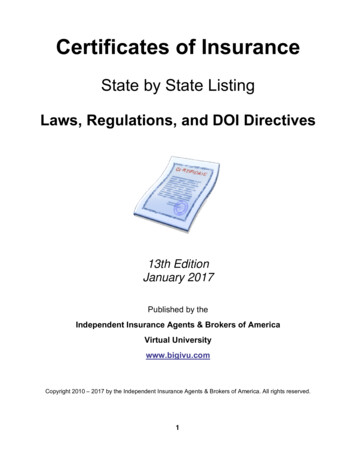
Transcription
Certificates of InsuranceState by State ListingLaws, Regulations, and DOI Directives13th EditionJanuary 2017Published by theIndependent Insurance Agents & Brokers of AmericaVirtual Universitywww.bigivu.comCopyright 2010 – 2017 by the Independent Insurance Agents & Brokers of America. All rights reserved.1
Table of ct of 2
7Nevada58New Hampshire59New Jersey61New Mexico63New York65North Carolina69North e Island79South Carolina80South 8Washington90West Virginia91Wisconsin92Wyoming963
Copyright Notice and DisclaimerDisclaimerThe purpose of this document is to assist agents and brokers in considering issues relevant to certificates ofinsurance. The document includes only general information, and is not intended to provide advice tailored to anyspecific insurance situations. It was prepared solely as a guide, and is not a substitute for agents and brokersindependently evaluating any relevant business, legal or other issues, and is not a recommendation that aparticular course of action be adopted. If specific advice is required or desired, the services of an appropriate,competent professional should be sought.Copyright 2010-2016 by the Independent Insurance Agents & Brokers of America, Inc. All rights reserved.No part of this publication may be reproduced, stored in a retrieval system, or transmitted in any form or media orby any means, including without limitation electronic, mechanical, and recording, except for brief quotations inprinted reviews, and for the worksheets in the Appendix to be used by the authorized recipient of this publication,without the prior written consent of the Independent Insurance Agents & Brokers of America, Inc.Certificates of InsuranceState by State ListingLaws, Regulations, and DOI Directives13th Edition, January 2017Researched and Compiled by:William C. Wilson, Jr., CPCU, ARM, AIM, AAMThe most recent edition of this document can be found Regulations.aspxalong with a number of related documents and articles.4
AlabamaJune 5, 2004Chapter 482-1-062, General Property/Casualty Binders, Certificates of Insurance or Indemnity Agreements waseffective on June 5, 2004. This Department of Insurance regulation prohibits insurers and agents from issuingbinders, certificates, indemnity agreements, or any other type of instrument which amends, extends, or alters thecoverage provided by approved policy forms and endorsements without the written approval of the Commissionerof Insurance.Each certificate or memorandum of insurance issued to non-policyholders must include the statement: “Thiscertificate or memorandum of insurance neither affirmatively nor negatively amends, extends, or alters thecoverage afforded by policy number issued by .”The regulation also mandates that insurers must file any certificate or memorandum of insurance that is not thestandard ACORD or ISO Form “Certificate of Insurance.” In other words, non-ACORD and non-ISO forms cannotbe used unless filed with the Department of Insurance.In addition, insurers and agents cannot issue an “Agent’s Opinion Letter” or any other correspondence purportingan insurance policy provides coverages which the policy does not provide. According to a September 22, 2003letter to agents from the Deputy Insurance Commissioner, under Title 27-7-19, violations may be subject to a 10,000 fine and imprisonment of up to one (1) year for EACH violation.December 22, 2010This letter was provided to the Alabama Independent Insurance Agents association by the Alabama Departmentof Insurance to clarify the law:Dec. 22, 2010Victor D. McCarley, CICExecutive Vice PresidentAlabama Independent Insurance Agents141 London ParkwayBirmingham, Alabama 35211Dear Vic:It has been brought to our attention that some parties are not accepting the new ACORD 25 (“Certificateof Liability Insurance”) or are trying to compel use of other certificate forms. We believe these issues arelargely answered by reference to Department Regulation 482-1-062, available in the “Legal” section of theDepartment’s web-site (www.aldoi.gov).Hopefully, the following clarifies the Department’s position on these matters:1. If properly licensed or authorized by the respective organization, an insurer and a producer actingfor an insurer can use the certificate of liability insurance forms published by ACORD (andISO ) without further approval from the Department. Department rule 482-1-062-.03(4).2. Effective October 1, 2010, ACORD form 25 (2009/09) or later version (2010/05) is the form thatmay be permissibly used. Prior versions of this form have been superseded and may not beused.3. An insurer or producer acting for an insurer may not use another certificate form unless that formhas been previously submitted to and approved by the Department. Department rule 482-1-062-5
.03(4). This includes certificate forms or forms in the nature of certificates devised by otheragencies or third parties.4. A certificate form must comply with Department rules 482-1-062-.03(1), -(2), and –(3). In general,a certificate is merely informational and cannot affirmatively or negatively create, change, extend,or restrict coverage provided for in the underlying insurance policies to which the certificaterefers. Neither an insurer nor a producer acting for an insurer may alter a certificate form if theeffect of that alteration is to change, or create the impression of changing, the terms or scope ofcoverage provided for in the underlying policies.5. Neither an insurer nor a producer acting for an insurer may issue an “opinion letter” or othercorrespondence stating or representing that an insurance policy provides coverage or containsterms which the policy does not provide or contain. Department rule 482-1-062-.03(5).6. A producer participating in actions which violate Regulation 482-1-062 can be subject todisciplinary action including the possibility of a license revocation or suspension and/or impositionof a fine.I trust the letter explains the Department’s position. You are free to distribute this as you thinkappropriate.Charles M. Angell FCAS, MAAAActing Deputy Commissioner & Casualty ActuaryAlabama Department of InsurancePhone: (334) 240-4422Fax: (334) 206-6386 Alternate Fax: (334) 240-4409Email: Charles.Angell@insurance.alabama.govAgency Web Site: http://www.aldoi.gov6
AlaskaNo known certificate-specific laws, regulations, or insurance department directives.7
ArizonaJanuary 11, 2011State of ArizonaDepartment of InsuranceREGULATORY BULLETIN 2011-01[1][1]TO: Property and Casualty Insurers and Producers Writing Business in Arizona and Other Interested PartiesFROM: Christina UriasDirector of InsuranceDATE: January 11, 2011RE: CERTIFICATES OF INSURANCEThe purpose of this Regulatory Bulletin is to address the prohibited practice of misrepresenting insurancecoverage when insurers or insurance producers issue certificates of insurance. The Arizona Department ofInsurance (ADOI) is aware that some licensed insurance producers and/or insurers receive requests to issuepreprinted certificate of insurance forms, or other evidence of coverage, which may include language thatattempts to amend, extend or alter the coverage of the underlying policy, or inaccurately suggests the existenceof certain contractual rights such as “hold harmless” agreements. The industry typically uses certificates ofinsurance in lieu of providing a full copy of the policy, serving as proof of insurance and summarizing policy forms.Although producers and/or insurers do not file the actual certificate forms or other evidence of coverage with theADOI, they do file and ADOI approves the policy forms they summarize.Certificates of insurance must clearly and accurately state the insurance coverage provided. Any certificate ofinsurance issued by an insurer or producer that obscures or misrepresents the insurance coverage or terms of aninsurance policy violates Arizona law. When an insurer or insurance producer issues a certificate of insurance orother evidence of coverage that exceeds a mere synopsis of the policy, the insurer or producer risks modifyingthe policy’s terms or conditions. Therefore, an insurance producer may not issue a certificate of insurance thatdoes not accurately represent the terms or conditions of the policy without written authority from the insurer toalter the terms or conditions of that policy, or unless the producer has written underwriting authority to do so.A.R.S. §20-443 (A)(1) prohibits a person from misrepresenting the terms of any policy issued, or to be issued, ormisrepresenting the benefits to be received. An insurer or insurance producer who issues a certificate ofinsurance that misrepresents or obscures the terms or conditions of the underlying policy violates A.R.S. §20-443and this may result in administrative action for suspension or revocation of a producer’s license or an insurer’scertificate or authority, civil penalties and, if applicable, restitution. Further, knowingly issuing such certificates ofinsurance may be prosecuted as a class 5 felony. A.R.S. §20-443.01.This bulletin is available on the Department’s web site, www.azinsurance.gov. For questions about the bulletin,please contact Gerrie Marks, Deputy Director at 602/364-3471, or lletin/2011-01.pdf8
ArkansasDecember 7, 2010On December 7, 2010, Arkansas released their first directive on certificates, taking a firm stance on what agentscan and cannot do. In fact, Arkansas extends this to policyholders and third parties:"[I]f a policyholder or other person knowingly and intentionally encourages a producer to provide thepolicyholder or other person a Certificate of Insurance or Evidence of Coverage which misrepresents thebenefits, advantages, conditions or terms of his or her insurance, that person may be committing fraud inviolation of Arkansas law."The bulletin goes on to say that any certificate that "conflicts with or purports to alter any policy coverage,exclusion, provision or condition, including in the case of Evidence of Insurance forms altering the Notice ofCancellation or providing Additional Insured status to the certificate holder except as stated in the insurance policyor in an endorsement" would effectively be considered a policy form and subject to filing requirements.otherwise,if not so filed, it could be construed as a misrepresentation or fraud.Here is the complete Bulletin No. 7-2010:http://www.insurance.arkansas.gov/Legal Dataservices/Bulletins/7-2010.pdf9
CaliforniaEnactment date unknownCalifornia Insurance Code, Division 1, Part 1, Chapter 4, Article 1, Section 384 says:384. (a) A certificate of insurance or verification of insurance provided as evidence of insurance in lieu ofan actual copy of the insurance policy shall contain the following statements or words to the effect of:This certificate or verification of insurance is not an insurance policy and does not amend, extend or alterthe coverage afforded by the policies listed herein. Notwithstanding any requirement, term, or condition ofany contract or other document with respect to which this certificate or verification of insurance may beissued or may pertain, the insurance afforded by the policies described herein is subject to all the terms,exclusions and conditions of the policies.(b) This section is not applicable to a surplus line broker certificate as defined in Section 48.10
ColoradoDecember 1, 2007Colorado insurance department Bulletin No. B 5.21, issued on December 1, 2007, prohibits the modification ofpolicies by certificates. Specifically, the Bulletin states:Existing law requires licensed property and casualty producers, agencies and insurers to be truthful inrepresenting the benefits, advantages, conditions, or terms of any insurance policy. There is evidencethat there is pressure on insurance producers to issue non-standardized or altering standard certificatesof insurance, which incorporate "hold harmless" agreements or other types of clauses that attempt tomodify the terms or conditions of the underlying insurance policy. Insurance producers should not issue acertificate of insurance that does not accurately represent the terms or conditions of the policy.Certificates of insurance generally serve only as evidence of insurance in lieu of an actual copy of aninsurance policy. An insurer is under no obligation to abide by any certificate of insurance; which hasbeen modified or created by any person or entity that does not have the actual or apparent authority to doso. Distribution of a certificate of insurance that has been modified, without authorization or the use of anon-standard certificate of insurance not authorized by the insurer, would at the least be misleading andcould be in violation of Colorado Insurance Laws.11
ConnecticutNovember 9, 2010BULLETIN S-14November 9, 2010TO: COMPANIES LICENSED IN THE STATE OF CONNECTICUT TOWRITE PROPERTY-CASUALTY INSURANCE AND PRODUCERSLICENSED IN THE STATE OF CONNECTICUTRE: USE OF CERTIFICATES OF INSURANCEThe purpose of this Bulletin is to outline the proper use of certificates of insurance and also to explicitly state thatthe improper modification of certificates of insurance is an unacceptable business practice.Certificates of insurance generally serve only as evidence of insurance in lieu of an actual copy of an insurancepolicy and are typically requested in connection with insurance-related contractual requirements. Certificates arefrequently issued by an insurance producer and they inform a company or individual who is not a party to theinsurance policy---called a Certificate Holder-of the coverages under the insurance policy or policies that havebeen issued.Generally, a certificate of insurance contains a snapshot of the insured's coverages as of the day of issue and itconfers no rights or benefits upon the third party certificate holder to the underlying insurance stated in thecertificate. This means that a certificate holder is owed no duty to be notified in the event the insurance policyidentified on the certificate is cancelled. A certificate of insurance does not have the effect of making thecertificate holder an additional insured under the underlying policy. To receive that protection, the certificateholder would need to be named an "Additional Insured" by endorsement or by being named an insured under theterms of the underlying policy. In some cases, there may be a cost for such protection. Certificate holders shouldseek advice concerning the different types of Additional Insured coverage and the scope of protection they mayoffer.It has come to the attention of the Department that some public or commercial organizations may be requestingthat contractors and/or insurance producers issue certificates of insurance that evidence terms or conditions ofcoverage that may be inconsistent with the underlying insurance policy or contract. The Department wishes toinform insurance producers and all other individuals that certificates of insurance cannot be used to amend,expand or alter the terms of the underlying insurance policy.Insurers and producers are reminded of the provisions of the Connecticut Unfair Insurance Practices Act at Conn.Gen. Stat. Sections 38a-815 and 38a-816(l )(a) which provides that it is an unfair insurance practice to make,issue or circulate a statement that "[m]isrepresents the benefits, advantages, conditions or terms of any insurancepolicy." Such a violation subjects a person making such a statement to fines, license revocation or suspensionand orders of restitution pursuant to Conn. Gen. Stat. Section 38a-817.Providing a certificate of insurance that misrepresents policy terms or conditions would violate Connecticut lawand subject the insurance producer to penalties that may include suspension or revocation of the producer'slicense.The Department urges all insurers to review their oversight procedures regarding the issuance of certificates ofinsurance in order to avoid misrepresentations of the terms and conditions of their policies and to periodicallyremind their producers about the consequences of providing improper certificates of insurance to the public.Thomas R. SullivanInsurance Commissionerhttp://www.ct.gov/cid/lib/cid/Bulletin S-14 - Use of Certificates Of Insurance.pdf12
2014 Update:Connecticut has passed Public Act No. 14-74 (H.B. 5248) effective October 1, 4-R00HB-05248-PA.htm13
DelawareDelaware has passed COI 47.nsf/vwLegislation/HB 104/ file/legis.html?open14
District of ColumbiaNo known certificate-specific laws, regulations, or insurance department directives.15
FloridaJune 17, 1994Florida has not yet addressed certificates from the standpoint of statutes or regulations, but the insurancedepartment as issued two regulatory orders dealing with modification of certificates:A Florida Office of Insurance Regulation Bulletin 94-014, dated June 17, 1994 said in part:Many cities, counties and corporate insureds have preprinted or modified Certificates of Insurance thatare not the same as those normally used by insurers. Some of those certificates have been modified toincorporate "hold harmless" agreements or other clauses that differ from the language in the policy.Certificates of Insurance are merely evidence of insurance in lieu of an actual copy of the insurancepolicy. They are to be used to show evidence of insurance. They are not to be used to attempt to modifythe terms of the policy itself. No insurer or agent should issue or sign a Certificate of Insurance thatcontains terms or conditions that differ from those in the underlying policy.February 21, 2003On February 21, 2003, the Florida Office of Insurance Regulation issued Information Memorandum OIR-03-003M“Certificates of Insurance” which said in part:The purpose of this Memorandum is to address the improper practice of modifying certificates ofinsurance. It has been brought to the attention of the Office of Insurance Regulation that some individualsor entities may be printing or altering certificates of insurance to incorporate ‘hold harmless’ agreementsor other types of clauses in an attempt to modify the terms or conditions of the underlying insurancepolicy.Certificates of insurance generally serve only as evidence of insurance in lieu of an actual copy of aninsurance policy. An insurer is under no obligation to abide by any certificate of insurance which has beenmodified by any person or entity which does not have actual or apparent authority to do so. Distribution ofa certificate of insurance which has been modified without authorization and which purports to alter theprovisions of the underlying policy, misrepresents the conditions or terms of the insurance policy inviolation of Section 626.9541(1)(a)1, Florida Statutes, thereby subjecting the person or entity modifyingthe certificate to license discipline and administrative fines.Insurers are requested to notify their agents regarding this uly 1, 2012HB 1101 becomes effective. The bill codifies Memorandum OIR-03-003M (see above) relating to alteredcertificates of insurance. According to the Memorandum, "distribution of a certificate of insurance which has beenmodified without authorization and which purports to alter the provisions of an underlying policy, misrep
Ohio 73 Oklahoma 75 Oregon 77 Pennsylvania 78 . or any other type of instrument which amends, extends, or alters the coverage provided by approved policy forms and endorsements without the written approval of the Commissioner of Insurance. Each certificate or memorandum of insurance issued to non-policyholders must include the statement .
